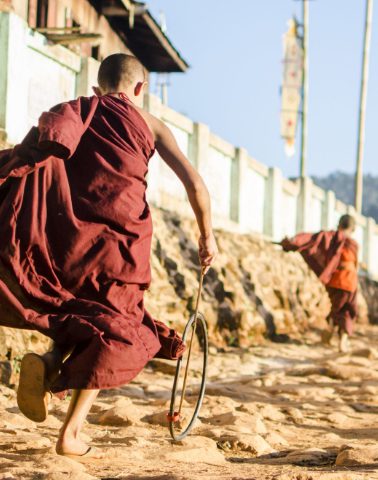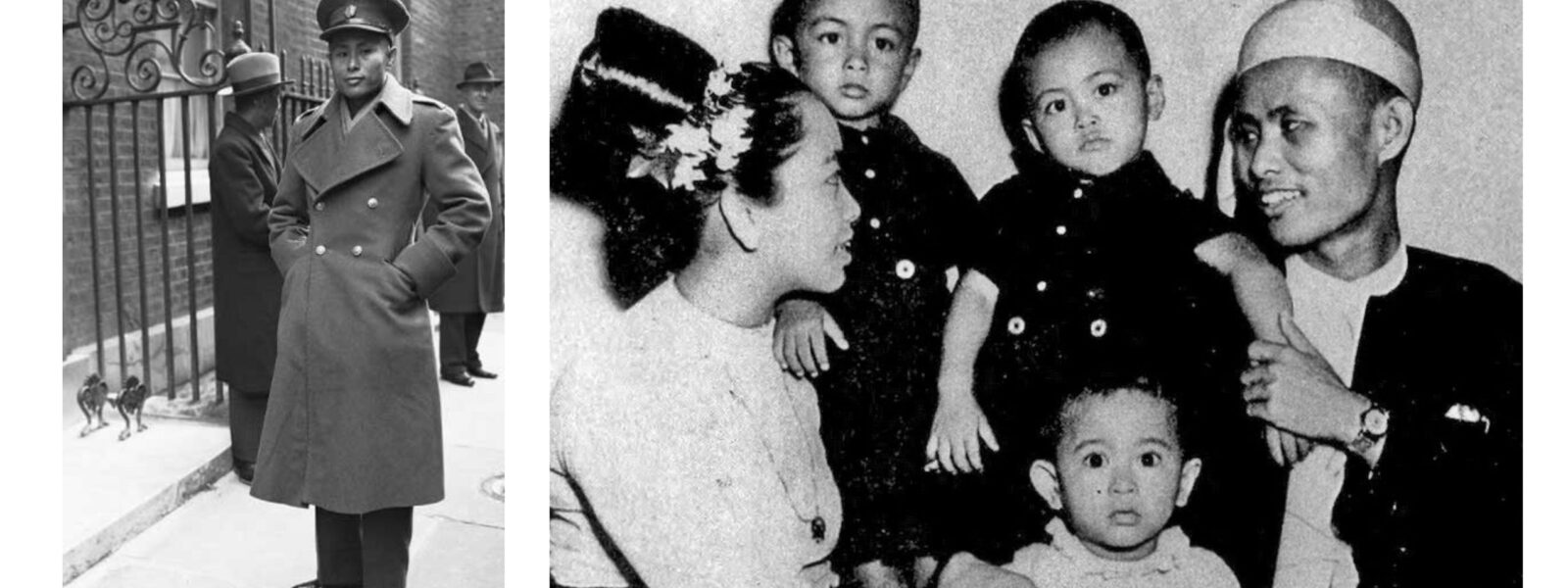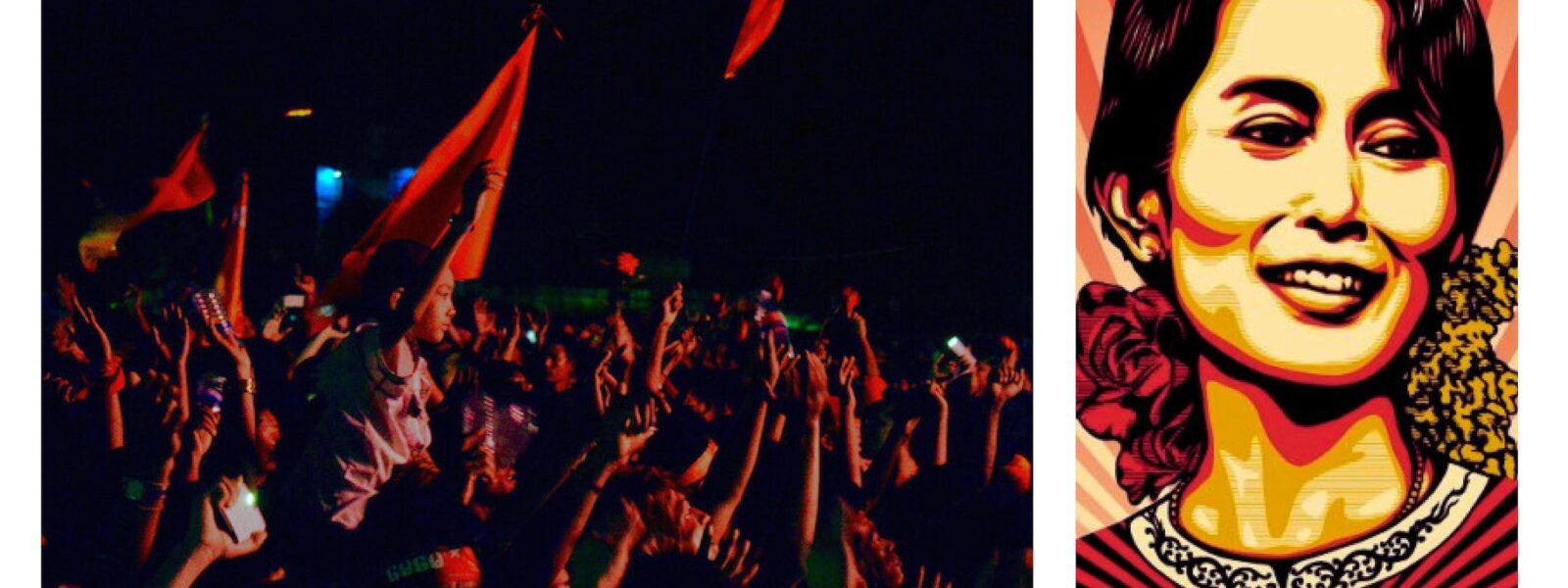
Subscribe to our mailing list
We are still here! Let us send you tips for travelling through Myanmar and stories from the road …
Her name is magic within Myanmar and internationally it is synonymous with the peaceful struggle for democracy. Since she was first arrested by the Burmese military, Suu Kyi has become, next to the Dalai Lama, the most famous campaigner for non-violent resistance since Mahatma Gandhi.
The first part of her name comes from her father, General Aung San, the ‘architect of Burmese freedom’. Aung San fought against both the British and the Japanese in the quest for his country’s independence and was leading his troops against the latter when his wife gave birth to their daughter on 19th June 1945.
After the war the family was reunited in Rangoon and the turbulent life of Aung San Suu Kyi began, ‘cradled in the arms of her father’s soldiers.’ Burma was on the cusp of achieving sovereignty when Aung San was assassinated by political rivals. He was thirty-two years old; his daughter only two.
Too young, one might suppose, for her father to have had any pronounced influence on her. However Aung San Suu Kyi’s history had begun with her namesake before she was born and she would never forget her heritage after his death. Moreover, she would grow to embody the resilience and fearlessness that Aung San had been revered for.
In the eyes of the Burmese people, as the academic Josef Silverstein writes, Suu Kyi would become the ‘reincarnation of her father […] destined to carry out his unfinished job of leading Burma into the modern world.’

However Aung San Suu Kyi is as much her mother’s daughter as she is her father’s. She has described her upbringing as that of a ‘soft person who had to toughen up.’ Daw Khin Kyi had high standards and strict morals: the backs of her children were never allowed to touch the dining room chairs, they would spend hours walking around their lawn to master a correct posture, and their hands weren’t ever permitted to rest idle.
Daw Khin Kyi and her friends were ‘the most progressive, liberal-minded and westernised in Rangoon’; a strata of Burmese society that was living on borrowed time after the coup of General Ne Win. Due to the fear of her becoming, if not a direct rival, a figure around which dissenters could rally, in 1960 the dictatorial general appointed Daw Khin Kyi Burma’s ambassador to India in New Delhi.
Here Suu spent her free time on Japanese flower arrangement and riding horses in the exercise grounds of the President’s bodyguards. Her studies however were tantamount and she matured under the expectation that she would go on to carve out a prosperous career. She was on this trajectory when in 1964 she left India to take up a degree at Oxford University.

The move to Great Britain was a stark change. Aung San Suu Kyi arrived during an explosion of popular culture bopping to the sound of The Beatles. The liberal Harold Wilson was Prime Minister and, as Peter Popham writes in Aung San Suu Kyi’s biography, ‘skirts were racing up girls’ thighs and erotic boots were closing the gap.’
One friend wrote that the defining impression Suu gave was one of ‘cleanliness, determination, curiosity, [and] a fierce purity.’ Despite her disapproval at the waywardness of fellow students, Suu seemed keen to try most things at least once. She would go punting alone, returning to the college wet but triumphant; she intentionally stayed out past curfew one evening so she too could experience being hoisted over the college wall; and on an afternoon during her final year, in the Bodleian Library she snuck into a cubicle with a small bottle of wine which she drank swiftly before decisively rejecting alcohol forever.
Suu had met Michael Aris through mutual friends in England and accepted his marriage proposal while in New York working for the UN in 1971. There was one caveat to her consent which in hindsight is haunted with foreboding. She wrote to him that year:
‘I only ask one thing, that should my people need me, you would help me to do my duty by them. … How probable it is I do not know, but the possibility is there.’
How probable Aris thought it was is unknown, but he gave his promise and the two were married in 1972. After a brief stint in Bhutan where Suu taught English to the royal bodyguards – who were reduced to cowering shadows of their former selves by their stern teacher – the two returned to the UK.
By 1985 the couple had two sons and an ageing terrier called Puppy, and Suu was casting around for a role beyond that of an Oxford housewife. She began to write a biography of her father which led to enrolling at Kyoto University in Japan. This proved to be a turning point. Not only was she spending her days buried in the history of her father but she also came into contact with young Burmese students who regarded her not only in awe, but also with expectancy.
Her first biographer Yoshikazu Mikami writes that ‘her sense of mission began to grow.’
It was a quiet evening in Oxford when the phone rang with the news that Aung San Suu Kyi’s mother had suffered a stroke. She began packing for Burma that night while Aris had the premonition that their lives would change forever.
Back in Burma the streets were in uproar. A fracas between students and government personnel in a teashop in Mandalay had been an early sign of discontent bubbling over the surface. On the 8th August 1988, at exactly 8 minutes past 8 in the morning, dockworkers laid down their tools and walked off the job. Soon thousands of Burmese were marching in defiance of martial law in fury against the nonsensical, dictatorial rule of Ne Win.
Surrounded by injured and dying protesters Suu Kyi found herself at the kernel of the resistance. Later joined by Aris and her sons, in front of a crowd of thousands outside Shwedagon Pagoda, Suu Kyi proclaimed the current protests as ‘a second struggle for national independence.’ By directly quoting her father, Suu Kyi was ripping him away from the military he had founded and who had since appropriated his image to justify their iron-grip on the country; Suu Kyi was aligning Aung San once more with the fight for Burmese freedom. As Popham writes, Aung San Suu Kyi’s speech was a declaration of war.
By directly quoting her father, Suu Kyi was ripping him away from the military he had founded and who had since appropriated his image to justify their iron-grip on the country; Suu Kyi was aligning Aung San once more with the fight for Burmese freedom … a declaration of war.
After much bloodshed Ne Win announced that he would resign and the country was to hold elections. Suu Kyi founded the National League for Democracy (NLD) and began touring the country to meet ardent supporters. In the face of outraged opposition from the military, she enforced a strict policy of non-violent but steadfast protest.
This was put to the test when walking with NLD members through the town of Danuphyu. She refused to turn back when commanded to by an infuriated captain who ordered his soldiers to fire if she did not stop. Calmly and in silence Suu Kyi walked towards the troop, their hands shaking as they directed their guns, until a major arrived and screamed for the soldiers to stand down.
Suu Kyi has always made light of this moment but it was the point when her mystique crystallized and displayed the potential her version of defiance could have over the brute force of the regime.
On Martyrs Day in July 1989 the military struck back, arresting students in Yangon and detaining all the high ranking members of the NLD. Suu Kyi was put under house arrest, her sons’ Burmese passports were declared invalid, and when the NLD won a landslide victory in the general election the result was ignored. Forty of the NLD’s elected politicians were arrested, two of whom later died under torture.
Suu Kyi was released from detention in 1995. The populace was just as much in thrall with her as they had been 6 years earlier, congregating to listen to her speeches delivered atop a rickety chair behind the gates of her house.
At this time of optimism returning in Myanmar, in Oxford Aris was diagnosed with prostate cancer. The junta sprung on this opportunity denying all Aris’ requests for a Burmese visa. They ignored pleas for mercy from people such as Prince Charles and the Pope, but habitually told Suu Kyi that she was free to leave Myanmar at anytime to be with her husband in England. Through unknown torment, Suu Kyi stayed put, aware that once she left the country she would never be allowed to return. Aris died on 27th March 1999, less than three months after the diagnosis.
In 2002 Suu Kyi was released and promptly took her democracy-show back on the road. General Than Shwe was now No. 1. This brutish man wanted to eliminate Suu Kyi and orchestrated an attack when she was travelling through the town of Depayin north of Mandalay. The NLD convoy was halted by two men pretending to be monks when an ambush of 4,000 thugs poured upon them.
Wunna Maung, one of Suu Kyi’s bodyguards, described what happened next:
“Because we had been told to never use violence, we tried to protect Suu’s car by surrounding [it] with our bodies in two layers… The attackers appeared to be either on drugs or drunk [and] struck down everyone including youths and women … When victims, covered in blood, fell to the ground, the attackers grabbed their hair and pounded their heads on the pavement until their bodies stopped moving.”
Suu Kyi narrowly escaped with her life, but seventy of her party did not. She was detained for a month in Insein Prison before returning to house arrest. Little was seen of her until the monk-led Saffron Revolution of 2007, when she addressed the monks from her rickety chair once more.
In 2010 Suu Kyi’s house arrest came to an end and, at a rapid pace that shocked the world, Myanmar began moving towards something which looked like democracy. After almost a quarter of a century of struggle, in May 2012 Suu Kyi took up her place in Myanmar’s parliament.
In 2016 the NLD won a landslide victory and Aung San Suu Kyi became the de-facto leader of her country.

General Aung San was assassinated not long after he had taken up politics. His daughter however has had to plough on in that grubby business, striving to realise the hopes and dreams she spent decades proclaiming.
It began well.
Soon after the NLD took power a score of political prisoners were released and significant peace talks were conducted with armed ethnic groups.
But doubt began to creep in. In 1989 Aung San Suu Kyi had written about ‘an Animal Farm syndrome where the new order after its first flush of enthusiastic reforms takes on the murky colours of the very system it has replaced.’ Many have accused the NLD of suffering under such a syndrome.
In Myanmar the last twelve months have seen a score of online defamation cases that have led to grave concern over freedom of speech. Since coming into power twenty people from Myanmar and three hundred and forty-one foreigners have been added to the visa blacklist, including a number of human rights activists that spent years campaigning for Suu Kyi’s release. There are political prisoners still in jail and students and others continue to be arrested for ‘unlawful assembly’.
In 1989 Aung San Suu Kyi had written about ‘an Animal Farm syndrome where the new order after its first flush of enthusiastic reforms takes on the murky colours of the very system it has replaced.’
In a rare interview, the BBC foreign correspondent Fergal Keane put it to Aung San Suu Kyi, that there was a ‘massive sense of disappointment’.
The fiercest criticism is that she has not spoken out enough about the crisis in Rakhine State where there are reports of ethnic cleansing, extra-judicial killing, and gang-rape at the hands of the Burmese military. In regard to this, in 2016 Suu Kyi’s fellow Nobel Peace laureates wrote an open letter urging her to ‘lead with courage, humanity and compassion.’
Odds are stacked against Suu Kyi. Myanmar is coming out of two generations of self-serving military rule; systematic change was never going to be instantaneous. The military still yields significant power; corruption is rife and the bureaucracy of government remains as turgid as Dickens’ Circumlocation Office.
The story of Aung San Suu Kyi is not yet over. Her name, like her father’s, remains a symbol for the fight for a better world. But it is also a reminder of the prevailing struggle of that fight. Daw Aung San Suu Kyi has not yet succeeded in all that she set out to do when she leapt into Burmese politics in 1988. But that is not to say that she has yet failed.